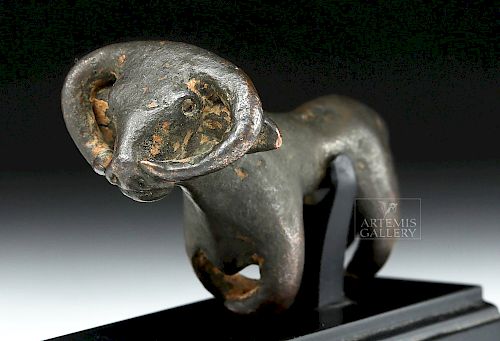Rare Sardinian Nuraghian Bronze Ram Figure
Lot 86a
About Seller
Artemis Fine Arts
686 S Taylor Ave, Ste 106
Louisville, CO 80027
United States
Selling antiquities, ancient and ethnographic art online since 1993, Artemis Gallery specializes in Classical Antiquities (Egyptian, Greek, Roman, Near Eastern), Asian, Pre-Columbian, African / Tribal / Oceanographic art. Our extensive inventory includes pottery, stone, metal, wood, glass and textil...Read more
Categories
Estimate:
$2,000 - $3,000
Absentee vs Live bid
Two ways to bid:
- Leave a max absentee bid and the platform will bid on your behalf up to your maximum bid during the live auction.
- Bid live during the auction and your bids will be submitted real-time to the auctioneer.
Bid Increments
| Price | Bid Increment |
|---|---|
| $0 | $25 |
| $300 | $50 |
| $1,000 | $100 |
| $2,000 | $250 |
| $5,000 | $500 |
| $10,000 | $1,000 |
| $20,000 | $2,500 |
| $50,000 | $5,000 |
| $100,000 | $10,000 |
| $200,000 | $20,000 |
About Auction
By Artemis Fine Arts
May 10, 2018
Set Reminder
2018-05-10 10:00:00
2018-05-10 10:00:00
America/New_York
Bidsquare
Bidsquare : Fine Ethnographic / Asian / Ancient Art
https://www.bidsquare.com/auctions/artemis-gallery/fine-ethnographic-asian-ancient-art-3213
Featuring antiquities from around the world including Pre-Columbian, Tribal, Classical, Asian, so much more! Artemis Fine Arts info@artemisgallery.com
Featuring antiquities from around the world including Pre-Columbian, Tribal, Classical, Asian, so much more! Artemis Fine Arts info@artemisgallery.com
- Lot Description
Europe, Sardinia, late Bronze Age to early Iron Age, Nuraghian period, ca. 9th to 6th century BCE. A petite yet sturdy statuette of a standing ram with characteristically simple features. The animal stands upon four bent legs beneath a slender torso, with its sinuous tail curving through the hind legs. The bulbous head displays a pair of large ears behind two enormous horns which curve in front of its face. The horns also frame the handsome visage, with its wide-set circular eyes, large snout, and thin mouth set below flared nostrils. Covered in a dark-brown patina, this is a fantastic example of Sardinian-era bronze work! Custom museum-quality display stand included. Custom museum-quality display stand included. Size: 2.5" L x 1.375" H (6.4 cm x 3.5 cm); 2.125" H (5.4 cm) on included custom stand.
Nuragic bronze statuettes are typical of Sardinian bronze-working from around the late bronze age to early iron age. Hundreds of bronze statuettes have been found across Sardinia during dozens of archaeological excavations, primarily in wells, holy sites, and villages. However, excavations in Central Italy have uncovered Sardinian bronzes that were placed within the burial sites of Etruscan tombs from around the 9th to 8th century BCE. Nuragic bronzes were created as representations of everyday things which were part of daily living, such as soldiers, deities, warriors and farmers, as well as animals like this example.
Provenance: private East Coast, USA collection
All items legal to buy/sell under U.S. Statute covering cultural patrimony Code 2600, CHAPTER 14, and are guaranteed to be as described or your money back.
A Certificate of Authenticity will accompany all winning bids.
We ship worldwide and handle all shipping in-house for your convenience.
#132426Surface wear and abrasions commensurate with age, small nicks to ears, horns, and legs, and fading to some facial features, otherwise intact and excellent. Light earthen deposits within recessed areas and lustrous dark-brown patina throughout.Condition
- Shipping Info
-
All shipping is handled in-house for your convenience. Your invoice from Artemis Gallery will include shipping calculation instructions. If in doubt, please inquire BEFORE bidding for estimated shipping costs for individual items.
-
- Buyer's Premium



 EUR
EUR CAD
CAD AUD
AUD GBP
GBP MXN
MXN HKD
HKD CNY
CNY MYR
MYR SEK
SEK SGD
SGD CHF
CHF THB
THB
















